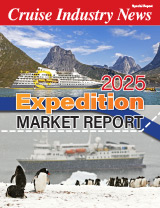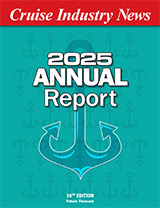Cruise Baltic’s members gathered in Copenhagen this week to talk with select industry representatives and discuss issues facing the organization and ports in the region.
Traffic is on the growth curve, with Copenhagen, Rostock and Oslo all reporting surges for 2011. Including some 50 more calls for Rostock, according to port officials.
“Europe, look out, this is the focus of our entire industry right now,” said Terry Dale, CEO and president of CLIA, talking to the audience.
Neil Palomba, chief operating officer at MSC Cruises, talked about the line’s growth, going from 127,000 passengers in 2003 to a projected 1.4 million worldwide in 2013. The line will homeport 35 times in the Baltic with three ships in 2011.
MSC will bring 450,000 passengers and a 30 million euro economic impact to the region in 2011.
Palomba urged the ports to rethink their fee structure.
“We just came out of a recession and have been continuing to deliver passengers,” he commented. “The only variable for us is yield, the ships always sail full, and while we have lost revenue, port costs are only going up.”
MSC carries more Germans onboard than any other nationality on Baltic sailings.
Cruise Baltic members suggested a port fee decrease for extending the season, which both AIDA and MSC said they were considering. However, the ports seem to realize that yields for the cruise lines are also very good in the Baltic.
And while AIDA’s Captain Burkhard Mueller, director of fleet services and operating line compliance, called the Mediterranean the cruise line’s “bread and butter”, 22.8 percent of capacity is in Northern Europe – compared to 33.3 percent in the Med.
“New capacity is getting deployed to Northern Europe,” he added, as AIDA has delivered and is planning to deliver a new ship every spring from 2007 to 2013.
“We achieve some of our highest yields on Baltic cruises,” Mueller continued. AIDA will add another four 10-day cruises, 15 in total, in 2011, and seven more 7-day cruises, going from 10 to 17.
Green
Robert Ashdown, technical director of the European Cruise Council, talked about all the green issues facing the Baltic.
Strict new rules are coming, including very tight sewage legislation in 2015, and more emissions laws.
New PM regulations may force cruise lines to use only distillate fuel in the region, and while no one can predict oil prices, Ashdown said that by looking at historical data, distillate fuel is 83 percent more expensive than traditional heavy fuel oil.
“New environmental regulations tend to be extremely expensive, and tend to have a much higher cost impact that originally anticipated, but we have to be responsible to the environment and the passengers,” he said.
Port representatives all had LNG on their minds, with some ferries in the high-traffic region starting to explore the fuel option.
Issues were raised regarding Norway, with one port official saying that Norway “passes rules without thinking about them, even considering a head tax for the fjords.”
Dale commented that as an industry, “we have not done a good job selling ourselves” (from an environmental point of view). Ports in the Baltic are continuing to battle negative press by local journalists that think cruise ships are destroying the environment.
Port officials told Cruise Industry News that they had tried to encourage local journalists to take environmental tours of ships in port, and were willing to arrange them, but no one seemed interested.
Agents
Palomba said that that a big threat were online travel agencies and tour operators, who could operate a much lower margin. And that there was not much MSC could do about “50 percent discounts on the internet.”
However, Dale urged that agents were “leaving money on the table by not selling pre- and post-cruise stay packages in the region.”
And while none of the cruise lines at the conference specifically polled passengers about ports, they all took negative comments into consideration.
AIDA had also just rolled out a new post-cruise survey, according to Mueller, that is available online.
“Before, passengers filled it out towards the end of the cruise, before the last day and disembarkation. It wasn’t totally accurate,” he explained.
Issues Aside
Challenges and port fee drama aside, a number of competing destinations, both small and large, came together to discuss the latest industry trends and talk to industry representatives.
Ports in the Baltic are expanding to compensate for more traffic. Oslo is looking into more berth space, according to port officials. At Copenhagen, a new pier is on schedule for 2013, according to Cruise and Ferry Manager Arnt Moller Pedersen.
MSC and AIDA both openly talked about extending the Baltic season, which is a positive sign, and member ports were willing to discuss early and late season port-fee discounting.
Be sure to subscribe to the Cruise Industry News Quarterly Magazine for a special in-depth feature section on the conference and the full-length behind-the-scenes article on Copenhagen Malmo Port.



